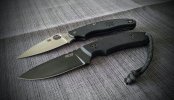anthonycastorena2014
Gold Member
- Joined
- Nov 27, 2014
- Messages
- 1,727
This topic came up in another thread, so I am starting this to avoid hijacking the original thread.
Lock strength tests like this one, are they idiotic and pointless, or do they provide useful data?
Me, I don't go out of my way to abuse knives (except one time). I still find these tests informative. If it is a knife I will depend on in the outdoors, I would prefer to go with a stronger lock (or none at all).
Please vote and share your thoughts, thanks. If you vote "other," please share your reason.
I voted yes because I use them hard if I need to and I don't want to worry. I can't believe I'm the first to ask but tell us about "Except one time" . Curiosity has taken over and I have to know...

